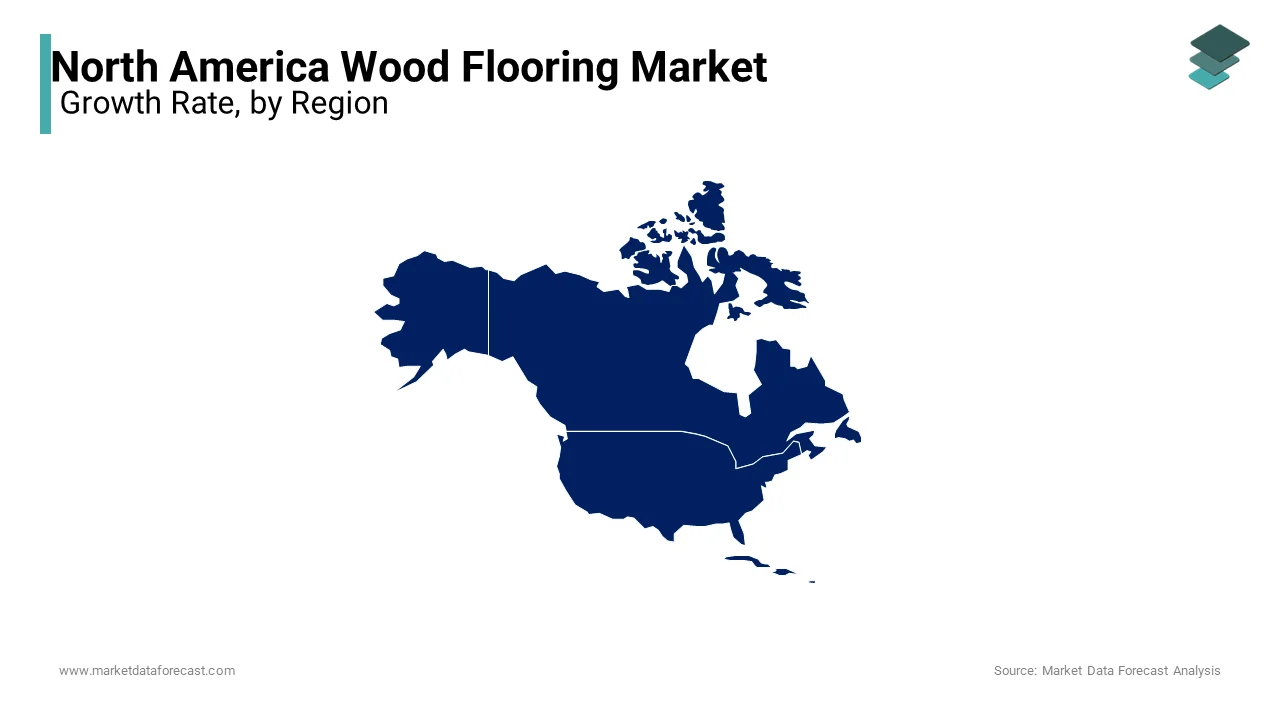North America Wood Flooring Market Size
The North America wood flooring market was valued at USD 7662.37 million in 2024 and is anticipated to reach USD 7850.86 million in 2025 from USD 9535.69 million by 2033, growing at a CAGR of 2.46% during the forecast period from 2025 to 2033.
The North American wood flooring market holds a significant position in the global construction and interior design industries. The residential construction sector has witnessed steady growth over the past five years, directly influencing the demand for premium wood flooring solutions. Canada, another key contributor, has seen a surge in eco-friendly housing projects, as mentioned by Natural Resources Canada. Despite challenges such as fluctuating raw material costs, the market remains robust due to technological advancements in manufacturing and installation processes.
MARKET DRIVERS
Rising Urbanization and Housing Starts
Urbanization has become a pivotal driver for the North American wood flooring market, with cities like New York, Toronto, and Los Angeles witnessing a construction boom. As per the U.S. Census Bureau, housing starts in the United States reached 1.7 million units in 2022, marking a 15% increase from the previous year. This surge is attributed to population migration toward urban centers, where wood flooring is preferred for its durability and aesthetic appeal. The affordability of engineered wood compared to solid hardwood has also broadened its appeal among middle-income households is contributing to the market’s expansion.
Sustainability Trends and Eco-Friendly Preferences
Sustainability trends are reshaping consumer choices, with wood flooring emerging as a preferred eco-friendly option. According to the Forest Stewardship Council, over 60% of North American consumers prioritize sustainable materials when making home improvement decisions. Engineered wood, sourced from responsibly managed forests, accounts for nearly 40% of total wood flooring sales, as noted by the American Hardwood Export Council. This environmental advantage is driving architects and builders to incorporate wood flooring into green building projects.
MARKET RESTRAINTS
Fluctuating Raw Material Costs
The volatility of raw material prices poses a significant challenge to the North American wood flooring market. According to the U.S. Bureau of Labor Statistics, the cost of hardwood lumber surged by 20% in 2023 due to supply chain disruptions and geopolitical tensions. This price instability impacts manufacturers’ profit margins by forcing them to pass on additional costs to consumers. These fluctuations deter budget-conscious buyers in the residential segment. Furthermore, Canada’s reliance on imported timber exacerbates the issue, as noted by the Canadian Lumber Trade Alliance. The unpredictability of these costs creates uncertainty is hindering long-term investments in production capacity.
Competition from Alternative Flooring Materials
Alternative flooring materials, such as luxury vinyl tiles (LVT) and carpeting, present a formidable challenge to the wood flooring market. These attributes make them particularly attractive in regions prone to moisture, such as coastal areas. Additionally, the Carpet and Rug Institute reports that carpets account for 45% of the total flooring market in North America due to their comfort and noise-reduction qualities. The versatility of these substitutes limits the penetration of wood flooring in certain applications. Furthermore, advancements in digital printing technologies have enabled LVT manufacturers to replicate the appearance of wood at a fraction of the cost, as per the International Interior Design Association.
MARKET OPPORTUNITIES
Growth in Remodeling and Renovation Projects
The remodeling and renovation sector presents a lucrative opportunity for the North American wood flooring market. The trend is fueled by homeowners seeking to enhance property value and aesthetics. Additionally, the rise of DIY culture, supported by platforms like Pinterest and YouTube, has made wood flooring installations more accessible to individuals. The Canadian Home Builders’ Association reports that 60% of renovations involve flooring replacements is favoring wood due to its timeless appeal. This shift not only expands the customer base but also drives innovation in product offerings, such as pre-finished and click-lock systems, thereby enhancing convenience and accessibility.
Technological Advancements in Manufacturing
Technological advancements are opening new avenues for the North American wood flooring market. Innovations in UV-cured finishes and laser-cutting techniques have improved product durability and customization options. These developments cater to the growing demand for personalized designs in high-end residential and commercial spaces. Furthermore, automation in production processes has reduced labor costs and increased efficiency by enabling manufacturers to offer competitive pricing. The integration of augmented reality tools for virtual try-ons is another emerging trend that enhances customer engagement and satisfaction. These innovations position wood flooring as a modern, adaptable solution, unlocking untapped market potential.
MARKET CHALLENGES
Environmental Regulations and Compliance
Stringent environmental regulations pose a significant challenge to the North American wood flooring market. The U.S. Environmental Protection Agency’s Formaldehyde Emission Standards require manufacturers to adhere to strict guidelines, increasing compliance costs. According to the American Chemistry Council, these regulations have led to a 10% rise in production expenses for small-scale manufacturers. Additionally, Canada’s commitment to reducing deforestation under the United Nations Framework Convention on Climate Change limits the availability of raw materials, as noted by Environment and Climate Change Canada. These policies, while necessary for sustainability, create operational hurdles for companies reliant on traditional sourcing methods. Non-compliance risks penalties, further pressuring businesses to invest in cleaner technologies. Balancing regulatory adherence with profitability remains a persistent challenge.
Economic Uncertainty and Consumer Spending Patterns
Economic uncertainty significantly impacts the North American wood flooring market, as consumer spending on non-essential home improvements declines during downturns. The Conference Board reports that consumer confidence in the United States dropped by 12% in 2023 by affecting discretionary purchases like premium wood flooring. High interest rates on mortgages and loans further discourage homeowners from undertaking large-scale renovations. The National Retail Federation notes that economic volatility often shifts consumer preferences toward cheaper alternatives, such as carpeting or LVT. This unpredictable spending behavior complicates market forecasting and forces companies to adopt flexible pricing strategies to maintain competitiveness.
REPORT COVERAGE
|
REPORT METRIC |
DETAILS |
|
Market Size Available |
2024 to 2033 |
|
Base Year |
2024 |
|
Forecast Period |
2025 to 2033 |
|
CAGR |
2.46% |
|
Segments Covered |
By Product, Wood Type, Application, End-Use, and Region |
|
Various Analyses Covered |
Global, Regional and Country Level Analysis; Segment-Level Analysis; DROC; PESTLE Analysis; Porter’s Five Forces Analysis; Competitive Landscape; Analyst Overview of Investment Opportunities |
|
Regions Covered |
The United States, Canada, Mexico & Rest of North America |
|
Market Leaders Profiled |
Mohawk Industries, Inc., Shaw Industries Group, Inc., Mannington Mills, Inc., Pergo, Flooring Innovations, EGGER Group, Goodfellow, Inc., Bruce Evans Flooring, LLC, Somerset Hardwood Flooring, Inc., Home Legend, LLC, DuChateau, Provenza Floors, Inc., Launstein Hardwood Floors, QEP Co., Inc. |
COUNTRY LEVEL ANALYSIS
The United States was the largest contributor with 75.8% of the North American wood flooring market share in 2024, with its robust construction sector and consumer preference for premium interior design solutions. This trend is further amplified by the rise of open-concept living spaces, where wood flooring enhances visual continuity and aesthetic appeal. The U.S. Green Building Council notes that wood flooring aligns with sustainability goals, as it is a renewable resource with a lower carbon footprint compared to synthetic alternatives. Additionally, the increasing adoption of engineered wood products, which offer affordability and durability, has broadened their appeal among middle-income households. Government incentives for green building projects under the LEED certification program further bolster demand by positioning the U.S. as a key growth driver in the regional market.

Canada’s vast forest resources provide a competitive advantage is enabling local manufacturers to produce eco-friendly products at scale. Canada’s commitment to reducing deforestation under international agreements has also encouraged the development of engineered wood products, which utilize less raw material while maintaining high-quality standards. Furthermore, Canada’s trade agreements with the U.S. facilitate the import and export of high-quality wood products is expanding market access and fostering cross-border collaboration.
KEY MARKET PLAYERS
Mohawk Industries, Inc., Shaw Industries Group, Inc., Mannington Mills, Inc., Pergo, Flooring Innovations, EGGER Group, Goodfellow, Inc., Bruce Evans Flooring, LLC, Somerset Hardwood Flooring, Inc., Home Legend, LLC, DuChateau, Provenza Floors, Inc., Launstein Hardwood Floors, QEP Co., Inc. are the market players that are dominating the global wood flooring market.
Top Players In The Market
Mohawk Industries
Mohawk Industries is a global leader in the wood flooring market, renowned for its innovative product portfolio and commitment to sustainability. This product addresses the growing demand for durable and moisture-resistant flooring solutions in humid regions. Mohawk’s acquisition of smaller firms specializing in engineered wood has further expanded its production capabilities by enabling it to meet diverse consumer preferences. The company’s emphasis on digital marketing and e-commerce platforms has enhanced its brand visibility by allowing it to reach a broader audience. Mohawk’s dominance in technological advancements, such as UV-cured finishes and laser-cutting techniques that ensures its position at the forefront of the industry.
Shaw Floors
Shaw Floors is a pioneer in sustainable manufacturing. The company’s acquisition of a sustainable forestry company in 2023 ensures its commitment to securing raw material supplies while adhering to eco-friendly practices. Shaw’s focus on green building projects aligns with consumer preferences for environmentally conscious products is driving demand in both residential and commercial sectors. Additionally, Shaw’s partnerships with architects and interior designers have strengthened its presence in high-end markets, where customization and quality are paramount. The company’s investment in automation and smart manufacturing technologies has reduced operational costs is enabling it to offer competitive pricing without compromising on quality.
Armstrong Flooring
Armstrong Flooring specializes in designing durable and aesthetically pleasing flooring solutions has making it a preferred choice for office spaces, retail outlets, and hospitality venues. Armstrong’s introduction of recyclable laminate flooring in 2024 reflects its commitment to sustainability, appealing to environmentally conscious consumers. The company’s integration of augmented reality tools for virtual try-ons has enhanced customer engagement, setting it apart from competitors.
COMPETITION OVERVIEW
The North American wood flooring market is characterized by intense competition, with established players and emerging entrants vying for market share. The fragmented nature of the industry encourages mergers and acquisitions, as companies seek to consolidate their positions and expand their product portfolios. For instance, Mohawk Industries’ acquisition of smaller firms specializing in engineered wood has enabled it to diversify its offerings and cater to evolving consumer preferences. The rise of e-commerce platforms has intensified competition by compelling brands to enhance their online presence and invest in digital marketing strategies.
RECENT HAPPENINGS IN THIS MARKET
- In April 2024, Mohawk Industries launched a new line of waterproof wood flooring, targeting the residential market. This innovative product addresses the growing demand for durable and moisture-resistant solutions in humid regions. The launch aligns with the company’s strategy to expand its product portfolio and capture emerging trends.
- In June 2023, Shaw Floors acquired a sustainable forestry company to secure raw material supplies. This move amplifies the company’s commitment to sustainability and positions it as a leader in eco-friendly manufacturing practices. By ensuring a steady supply of responsibly sourced materials, Shaw strengthens its competitive advantage in the market.
- In September 2023, Armstrong Flooring partnered with a tech firm to integrate augmented reality tools for virtual try-ons. This initiative enhances customer engagement by allowing users to visualize flooring options in their homes before making a purchase. The partnership reflects Armstrong’s focus on leveraging technology to improve the customer experience.
- In January 2024, Mannington Mills expanded its distribution network across Canada. This strategic move increases market access and enables the company to tap into Canada’s growing demand for premium wood flooring solutions. The expansion reinforces Mannington’s position as a key player in the North American market.
- In March 2024, Tarkett introduced a recyclable laminate flooring range, emphasizing eco-friendliness. This product aligns with the company’s sustainability goals and appeals to environmentally conscious consumers. The launch highlights Tarkett’s commitment to innovation and its ability to adapt to changing market dynamics.
MARKET SEGMENTATION
This research report on the North American wood flooring market is segmented and sub-segmented into the following categories.
By Product
- Solid Wood
- Engineered Wood
By Wood Type
- Red Oak
- White Oak
- Maple
- Others
By Application
By End-Use
- Replacement
- New Construction
By Country
- The United States
- Canada
- Mexico









